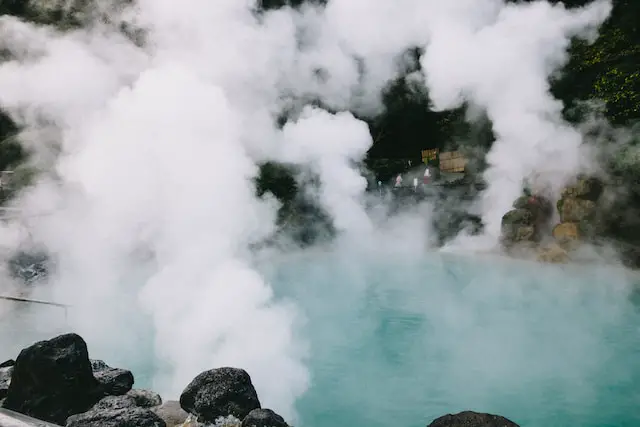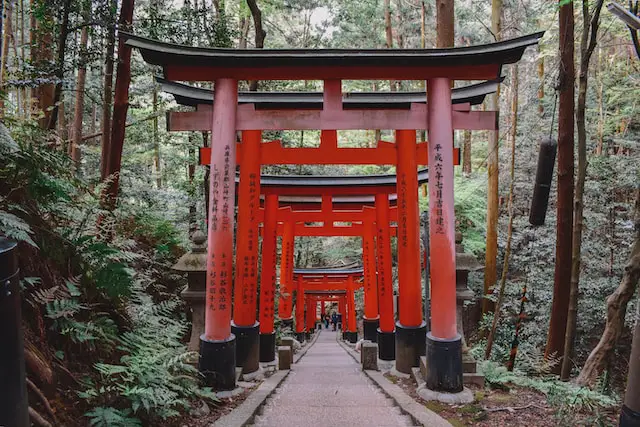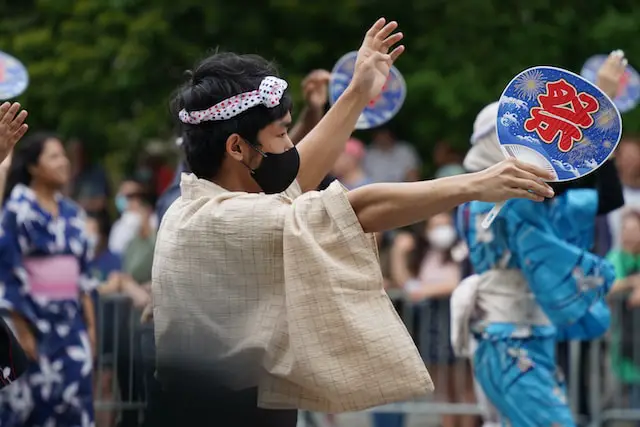When visiting Japan, immersing yourself in an Onsen, or Japanese hot spring, is a must-try experience. Revered for their therapeutic properties and their intrinsic ties to Japanese culture, Onsen bathing presents a unique opportunity to relax and rejuvenate. The variety of Onsen, from those nestled in snowy landscapes to those surrounded by lush, verdant forests, are all part of this compelling experience.
However, to truly appreciate this centuries-old tradition, it’s essential to understand the Onsen etiquette. These extensive, often unspoken, set of rules help maintain a harmonious, respectful, and clean environment for all. These customs are not only crucial for your experience but also ensure the comfort of your fellow bathers. So, before you set foot in these tranquil hot springs, join us as we navigate the warm, enchanting world of Japanese Onsen.
Prepping for Your Onsen Visit
Visiting an Onsen, or a Japanese hot spring, is more than just a quick drop-in affair. It requires careful planning and research to maximize your enjoyment and to abide by Onsen etiquette properly. Therefore, it’s essential to research and choose your Onsen based on location, the properties of the hot springs, and the types of facilities available.
Throughout Japan, there are thousands of Onsen, each boasting unique characteristics. Choosing an Onsen in a location that aligns with your travel plans is your first step. For instance, if you’re visiting Hokkaido, the Noboribetsu Onsen, with its sulfur springs surrounded by breathtaking forest vistas, is a must-visit. Alternatively, if you’re exploring the southern islands, Beppu Onsen in Kyushu, known for its ‘Hell Springs,’ offers a one-of-a-kind experience.
Depending on your preferences, you may opt for Onsen noted for specific properties. Some might be rich in sulfur, known for its skin-enhancing benefits, while others might contain sodium chloride, which can warm the body swiftly and can be therapeutic. Ain’t it remarkable how a relaxing dip might also be beneficial to your health?
Beyond the water’s properties, Japanese Onsen also vary greatly in terms of their facilities and ambiance. On one hand, you have the traditional Ryokan Onsen, often found in serene countryside settings, where you can savor a tranquil, timeless experience. Here, you are transported back to feudal times, where you wear Yukata (traditional robes), sleep on Tatami (straw mats), and enjoy meticulous Kaiseki cuisine. Contrastingly, modern ‘Super Sento’ or city Onsen offer a more diverse range of baths and sauna experiences in a vibrant, metropolitan setting.
Each Onsen type – traditional or modern – holds its own charm. The trick is to consider your needs, do your research, and pick an Onsen that mirrors your ‘perfect’ relaxation spot. You’re now one step closer to your ideal Onsen experience in Japan!
Understanding the Importance of Cleanliness in Onsen
Following cleanliness protocol at an Onsen provides a base for the respectful and peaceful environment it is known for. Every patron’s comfort is paramount for creating the serene ambiance, and a clean bathe space plays a vital role in ensuring this. Pre-bathing is also seen as a way to purify oneself before entering the tranquil Onsen waters. Notably, you should remember this is not a suggestion – but a strict Onsen rule that must be adhered to.
Now, you might worry about the exact process of pre-bathing. You’ll find a separate area where you’re expected to clean yourself thoroughly before enjoying the hot spring waters. These areas typically consist of stools, handheld showers, buckets, and toiletries including soap and shampoo. The seated showers are specifically designed to keep the soap and dirty water within your own washing space, ensuring the cleanliness of the communal area.
Begin by rinsing off your stool before sitting down. Then, rinse your body with the handheld shower, making sure to rinse from top to bottom. Next, lather yourself up with the provided soap and shampoo, and once again, rinse thoroughly. It’s crucial to ensure no soap remains on your body before you step into the Onsen, as this could contaminate the purity of the spring water. Also, make certain your hair doesn’t touch the water; many people tie up their long hair just to be safe.
Once you’re clean, you are ready to make the most out of your Onsen experience. Just remember, preserving the cleanliness and sanctity of the Onsen water for all to enjoy is an integral part of Japanese bathing etiquette.
Learning How to Use the Provided Towels
When you enter an Onsen, you’re typically provided with two towels, a large one for drying post-soak, and a smaller one often known as a “modesty towel”. The art of towel usage might seem insignificant, but it is an integral part of Onsen etiquette.
First, understand that the smaller towel is your primary friend during the bathing process. This towel is used to maintain modesty as you navigate the bathing area and can also be utilized to help clean yourself during the pre-Onsen bath. However, it’s essential to remember that this towel should never make its way into the warm waters of the Onsen itself. The springs are of fundamental cultural importance, and keeping them clean is a shared responsibility.
In case you’re wondering about what to do with this small towel while you’re enjoying the hot springs, there’s a simple solution. Just lightly fold the towel and place it on top of your head while you’re in the bath. This tradition may seem unusual to first-timers, but it’s a common practice among regular Onsen visitors. Not only does it keep your towel dry, but it’s also believed to have some health benefits, like preventing overheating.
The second, larger towel is used for drying off after your soak. Remember to keep this towel in your locker or designated storage area because it is not used until after your bath, and like the small towel, it should never enter the hot spring water.
Following these practices will demonstrate your respect for the Onsen culture and enhance your overall experience. Embracing these norms is part of the joy of immersing oneself in the traditions of Japan.
Navigating Through the Different Baths
Japan boasts a stunning variety of Onsen baths, each with its unique features, offering different health benefits and experiences to bathers. Understanding these variations will certainly enhance your Onsen experience.</p
Maintaining the right temperature is critical for a comfortable and relaxing soak, hence each bath in an Onsen might have a different temperature. Generally, you’ll find the water temperature in the outdoor baths (rotenburo) to be slightly lower, hovering between 38-42 degrees Celsius. Indoor baths often have higher temperatures, reaching as high as 44 degrees Celsius. Certain areas may have cooler baths too, particularly useful for gradually adjusting your body to the varying temperatures.
Remember, Onsen baths are not just about heat. There are baths with added elements meant for therapeutic benefits. A sulfur bath, for example, could help with skin ailments and improve blood circulation. Saline baths (Saltwater baths) often come with benefits like relieving muscle stiffness and promoting healthy skin. A carbonated spring (known as Niso Onsen) can improve your blood flow and lower blood pressure. So, pay attention to the constituent elements as they are often displayed near the baths.
If you are new to the Onsen experience, it is suggested that you start with a lukewarm bath, gradually moving to hotter ones. It’s not a competition to endure the highest temperatures, but about taking things at your own pace to savor and synch with the tranquil ambiance that defines the traditional Japanese hot spring bathing experience.
Despite the possibility of some initial unease due to different water temperatures, always remember – it’s all part of the quintessential nurturing Onsen experience, designed to leave you feeling reinvigorated and refreshed.
Respecting the Shared Silence
Onsen bathing isn’t merely about taking a dip in the hot spring; it is notably a silent and peaceful activity where one can dissolve stress and commune with nature. The distinct ‘silence in the Onsen’ plays a large part in the bathing culture, signifying respect for others who seek tranquility while immersed in the hot, relaxing waters.
Understandably, maintaining silence can be challenging, especially when you are sharing this experience with friends or loved ones. However, this is where the art of subtle communication comes in. For instance, whispers or hushed conversations are generally considered acceptable. Alongside, making use of gentle, non-verbal cues can be a wonderful way to communicate without breaking the serene atmosphere.
Remember, Onsen bathing is fundamentally a routine for relaxation, so keep your phones and other distractive gadgets away. Any loud chatter or noise can disrupt the balance and affect the therapeutic ambiance that the Onsen seeks to create. Enjoy the sounds of nature, the steam rising from the water, and the soft hush that envelopes the space.
Over time, you will come to appreciate this silence as a form of meditative practice, helping you deepen the relaxation process, connect with yourself, and recharge, ultimately leaving the Onsen with a refreshed and rejuvenated spirit.
Respecting the shared silence is a substantive element of the Onsen etiquette that allows you to fully harness the therapeutic powers of Japanese hot springs while offering a unique opportunity to experience an integral aspect of Japanese culture.
Onsen Tattoos and Other Taboos
Despite their blissful appeal, the world of the Onsen comes with its own set of rules and taboos that all visitors need to respect. One of the most prevalent among these is the longstanding rule surrounding tattoos.
Traditionally, tattoos are seen as a mark of the Yakuza, Japan’s organized crime syndicates, and thus bear a certain social stigma. As a result, many Onsen establishments strictly prohibit people with tattoos from using their facilities. Recently though, with the increasing number of foreign visitors having tattoos unrelated to criminal activity, some Onsen began to loosen their tattoo policies.
However, even with changes, it is always advisable to inquire ahead about an establishment’s tattoo policy before visiting if you have one. It’s worth noting some places might allow you to cover smaller tattoos using waterproof patches.
Even without tattoos, there are other taboos worth being aware of. Modesty is highly regarded in Japanese society, and one should avoid making splashy entrances into the bath. Moreover, any kind of bodily cleaning should be completed beforehand in the washing area. Swimming or playing around in the bath is also viewed as disrespectful.
Another important point is to never wring out your towel into Onsen water, instead, keep your towel on your head, or place it to the side while bathing. Lastly, while many Onsen can be enjoyed mixed-gender, the majority separate men and women. Check this beforehand to avoid any embarrassing mistakes.
By understanding and respecting these protocols, you can appropriately navigate the deeply ingrained Onsen etiquette. So, fancy a soak, while brushing up on cultural ins-and-outs of Japan? The steaming waters await!
Conclusion
The entrancing world of the Onsen is one of deep tradition and respect, providing an experience that transcends the everyday to offer a glimpse into the heart of Japanese culture. Each stage of the Onsen journey cultivates mindfulness and consideration for others, from the meticulous pre-bath cleansing to the shared silence in the hot springs. Through understanding and respecting local customs and etiquette, we not only honor the culture that has welcomed us, but we enrich our own experience and create lasting and meaningful memories.
The Onsen experience represents a slice of Japan that is therapeutic, both physically due to the healing properties of the mineral-rich waters, and mentally, through the serene and calming environment. Here, it’s not just about switching off our physical senses, but also about freeing our minds for a peaceful, meditative experience. The importance of leaving our towels outside the water, understanding the functions of the different baths, upholding silence, and respecting traditional taboos, come together to navigate this beautifully spiritual journey.
So, you’ve planned your trip, done your research and made your bookings. Now all you need to do is immerse yourself in this fascinating tradition. Remember, the rules aren’t there to restrict but to maintain the cherished heritage and ensure a wonderful experience for every visitor. While Japan offers a multitude of must-see sights and unique experiences, an Onsen visit truly offers a deeper dive into the values and traditions that continue to shape Japanese culture.
In a world constantly on the move, treating yourself to this tranquil retreat is not just a must-do—it is a gift for your well-being. So venture beyond the well-trodden tourist paths and dive headfirst into the warming waters of the Onsen—you won’t regret it.





